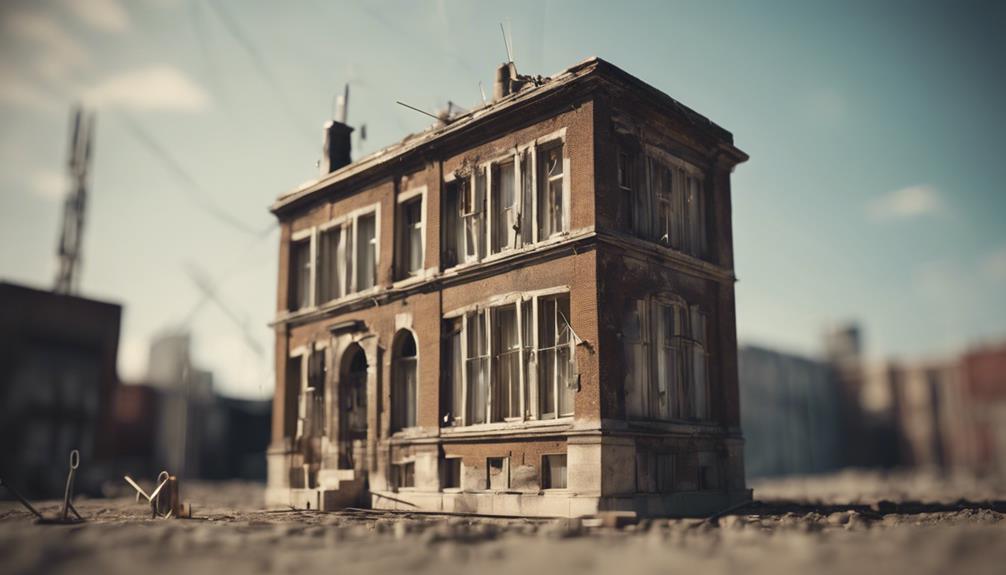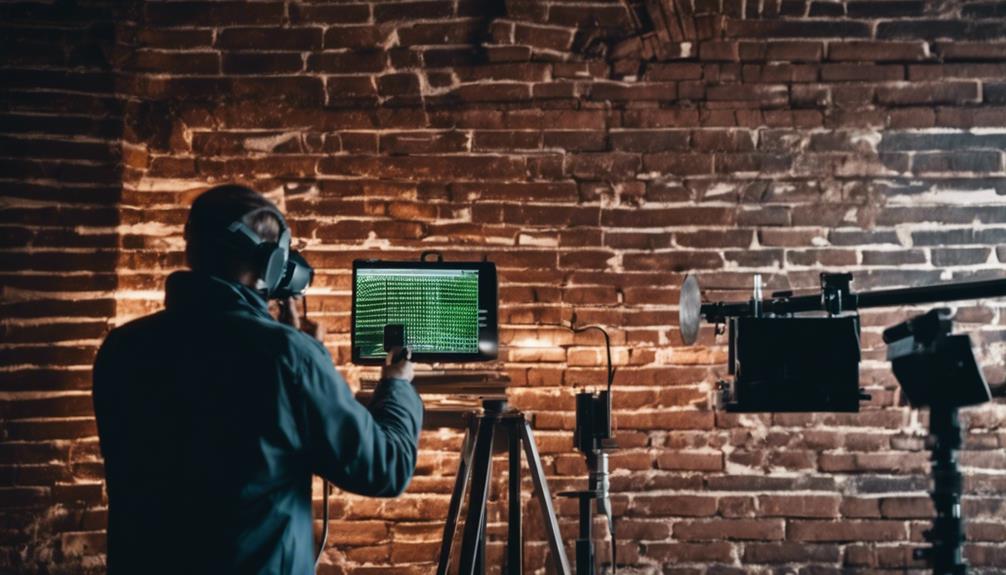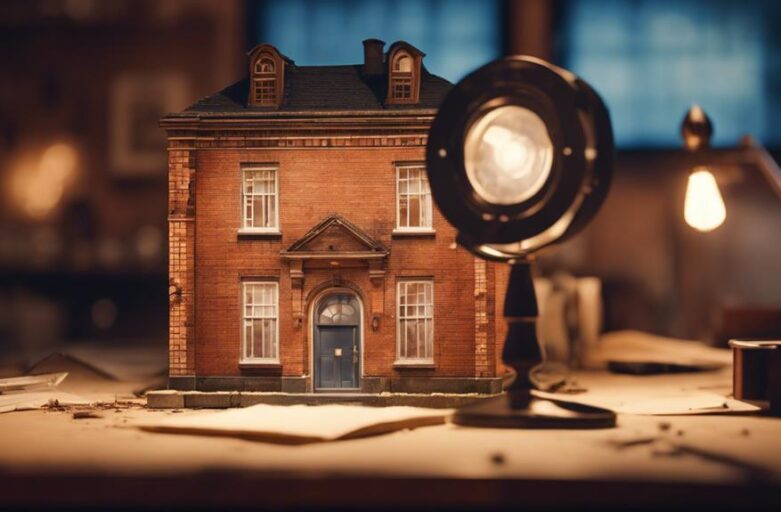When checking out old buildings, there are ten key steps to take. First, you need to analyze the structure. This tells you how the building is holding up under its weight. After that, you should look at the outside and inside of the building. This can help you spot any problems that may not be so obvious.
Next, you can use a tool called infrared thermography. This tool shows you differences in temperature, which can point out issues. Ultrasonic testing is another helpful tool. It uses sound waves to spot any problems.
You could also use ground penetrating radar or laser scanning. These tools can help you find hidden features and mistakes in the building. Another step is to measure the building's response to stress. This can show you where the building is weak.
There's also a tool called an endoscope. This can help you look at parts of the building that are hard to see, without causing any damage. Then, you can use acoustic emission testing. This listens for any hidden issues in the building.
The last step is to use radiographic testing. This lets you see any problems within the building. By following these steps, you can learn a lot about old buildings and how to keep them in good shape.
Key Takeaways
- A good look-over, inside and out, is the first step to finding hidden problems in old buildings.
- Using a special tool called an infrared camera, we can see if there are issues like leaks or bad insulation that can affect how much energy the building uses.
- Ultrasonic testing is like a super hearing device. It uses sound waves that are too high for us to hear to find problems in the building materials that we can't see.
- Laser scanning is like taking a 3D picture of the building. This can show us problems inside the building that we might not have found otherwise.
- Using a tool called an endoscope, we can check out hidden parts of the building without breaking anything. This helps us catch problems early and keep the building in good shape.
Understanding Structural Analysis
Structural analysis is like being a detective, but for buildings! It's all about figuring out if old buildings are still safe and strong. Engineers use cool methods like finite element analysis, which helps them see where a building might be under too much pressure. It's a bit complicated, but don't worry – there's a whole team of engineers who are ready to share their knowledge about this.
Really getting to know an old building means going on a time travel adventure. You have to know about the old ways people built things and the materials they used. This helps you figure out how the building is holding up after all these years. Understanding how weight is distributed and the properties of the materials used is super important. This helps you tell the story of the building, what's strong about it and what might need some extra care. You're not just watching – you're a key player in keeping these amazing buildings safe.
Importance of Visual Inspection
Visual inspection is super important, especially when you're checking out old buildings. Think of it like being a detective, looking for clues. You're not just glancing around. You're doing a careful, detailed check of both the outside and inside of the building. It's not hard to do, and it can save you a lot of trouble and money later on.
This kind of inspection is really important for old buildings. It helps you find problems that aren't obvious right away. You really need to spot these issues. They're key to the building staying strong and telling its historical story.
Plus, visual inspection doesn't hurt the building. It keeps the building safe while helping you learn about its state. It's about respecting and keeping the past alive, not wrecking it. It's about helping the building's story continue.
Utilizing Infrared Thermography

Think about having a special camera that lets you see things in old buildings that you can't usually see. This is what infrared thermography does. It's a smart method that uses this camera to show different temperatures inside structures. These changes in temperature can tell you a lot about a building's condition, like if it has hidden problems or areas that could become problems, like leaks, insulation troubles, or electrical faults.
Infrared thermography is a safe and simple way to find out about problems that you can't normally see. It's like being a detective for buildings, understanding the secret language of temperature changes. You can find out if water is getting in where it shouldn't, if insulation is missing, if the heating and cooling system isn't working well, or if there are dangerous hot spots in the electrical system. You can then fix these problems in a smart way, saving you time, effort, and resources.
But infrared thermography isn't just for finding problems. It's also for keeping a building in good shape. It's an important tool for checking how much energy a building uses and diagnosing any problems, helping you keep the building strong, use less energy, and last longer. So, grab that special camera and see what's hidden, feel powerful, and help keep old buildings safe for the future.
The Role of Ultrasonic Testing
Get set to discover the magic of ultrasonic testing!
Think of it like a super cool detective tool that uses high-pitched sound waves to scan old buildings.
This awesome tech helps us spot hidden problems and tells us how thick the materials are.
We're about to dive into how this tool works, what it's used for, and the hurdles it encounters.
All this helps to make sure our beloved old buildings stay in top shape.
Fundamentals of Ultrasonic Testing
Dive into the world of ultrasonic testing!
This cool method uses high-pitched sound waves to find hidden faults like cracks or gaps in building materials. It's a super important tool that helps us find problems hiding inside old buildings.
By using it, you can make sure your building is safe and strong.
The best part? This testing doesn't harm the material at all! It's like a superhero x-ray vision, letting you see deep inside without causing any damage.
It's a trustworthy and precise way to make sure your building is in top shape.
Join the ultrasonic testing team and help protect our old buildings!
Applications in Building Inspection
In the world of checking buildings for safety, a cool tool called ultrasonic testing is super important. It uses really high-pitched sound waves that we can't hear to find problems that we can't see. This helps make sure our older buildings are still safe and strong.
This method is like a superhero for buildings. It can find tiny cracks, layers that have separated, and empty spaces in parts of structures like concrete, metal, and mixed materials. It's like having a superpower in the world of building construction!
Here are some ways we use it, why it's cool, and what it can find:
| What We Use It For | Why It's Cool | What It Finds |
|---|---|---|
| Making Sure Things Are Made Right | Finds mistakes | Cracks we can see |
| Checking Safety | Makes sure things are solid | Layers that have separated |
| Looking After Buildings | Stops damage before it happens | Empty spaces in concrete |
Your job in this is super important. When you use ultrasonic testing to check buildings, you're like a superhero, too. You're making sure buildings are safe and strong. And you're keeping everyone who uses those buildings safe. That makes you part of a team that thinks safety, quality, and staying strong are the most important things.
Challenges and Solutions
Let's dive into the issues we face when we check out old buildings. One super cool approach is ultrasonic testing. It's like a superhero, using high-pitched sound waves to find problems like cracks or messed up wiring that could be dangerous. This isn't just about spotting issues, it's about making sure your favorite historical buildings are strong and safe.
Ultrasonic testing is like an X-ray for buildings, giving us details about the size, shape, and spot of the issues. This is really helpful for big or tricky structures where just looking at them isn't enough. So, it's not just about keeping history alive, but also about keeping people safe. When you use ultrasonic testing, you're part of a group that values both safety and history.
Ground Penetrating Radar Analysis
Let's dive into a super cool method called Ground Penetrating Radar Analysis, or GPR for short. This cool technique uses waves, similar to how a bat uses sound, to see what's happening inside old buildings and structures. It's kind of like having x-ray vision! And the best part? It doesn't hurt the structures at all.
We'll learn about how it works, explore why it's so useful, and look at some real-world examples. Get ready to see why GPR is a big deal in the world of inspecting buildings!
Understanding Radar Analysis Basics
Dive into the exciting world of Ground Penetrating Radar (GPR) analysis! This is a cool tool that uses special waves to see hidden secrets in old buildings.
Think of radar analysis as a superpower, letting you see beneath the surface of buildings without causing any harm. It's like having X-ray vision that shows things like metal bars, cables, and empty spaces inside the concrete.
GPR gives clear pictures and can see deep inside for a complete check-up. This handy technology helps you understand what's happening inside your building and make sure it's safe and sound.
Benefits of Radar Analysis
So, what's so great about radar analysis, you ask? It's kind of like having x-ray vision for buildings! Radar analysis uses something called GPR. It's a powerful tool that sends waves, like how a bat uses echoes, to see inside things without breaking them. It's very useful, especially when we want to keep old structures safe and sound.
Picture this: you have a gadget that sends out invisible waves. These waves can go through materials and bounce back, creating a picture of what's inside. It's like a high-tech game of hide and seek! You can find hidden things like tiny spaces or cracks, or even locate parts of the building like metal rods and tension cables.
With all this data, you can make smart choices about how to fix or renovate a building. It's like being a detective and a preservationist at the same time! You're not just keeping history safe, you're helping it to thrive. So, go ahead and love this awesome tech. It will make you feel super confident about taking care of structures.
Radar Analysis Case Studies
Delving into Ground Penetrating Radar (GPR) analysis is like opening a book full of exciting stories about old buildings. GPR uses special waves to see what's hidden beneath the surface of old structures, without any harm to them. Think of it as an X-ray for buildings. This way, we can see things like hidden pipes, the building's skeleton, or even empty spaces nobody knew were there.
What's more, GPR helps us to take care of old buildings, as it gives us real-time information. So, we can make smart decisions about how to look after them. GPR isn't just a cool gadget, it's our helper in keeping history alive.
Implementing Laser Scanning
Laser scanning is like a superpower that lets us see into old buildings without touching them. It uses laser beams to make 3D pictures that show exactly what's going on inside these structures. This technique can spot problems like cracks and defects, all while keeping the building safe and sound.
You could think of it as a special kind of X-ray vision. It peeks behind the outside walls and shows us the real condition of the building. This is great for old, historical buildings, as it helps us document and keep track of their state.
But it's not just about technology – it's also about preserving history. Laser scanning is like a tool in the hands of those who want to keep our architectural heritage alive. It's a chance for us all to contribute to the preservation of these fantastic old buildings. This way, the stories they carry can continue to be shared with future generations.
Structural Response Measurements

Structural response measurements are like a health check-up for old buildings. They help us figure out how a building reacts to forces like wind, earthquakes, and vibrations. It's a bit like understanding how your body responds when you run or carry a heavy bag.
To do this, we use special tools like accelerometers, strain gauges, and displacement sensors. These tools tell us how the building moves, carries its weight, and deals with nature's challenges. It's like getting to know a building's personality!
By studying these measurements, we can find out if there are any weak spots in the building. Finding a problem doesn't mean the building is bad, it just means we've a chance to make it better. We can use what we learn to decide if we need to fix or strengthen any parts.
Structural response measurements help us respect old buildings. They help us protect their history, keep them safe, and make sure they'll be around for many more years. It's all about caring for our buildings and making sure they're safe for everyone inside.
Benefits of Endoscope Inspection
Have you ever thought about how we can check old buildings' hidden spots without causing any harm? This is where endoscope inspection comes in. It's like having a tiny, bendy, advanced camera that can explore through the ins and outs of old buildings.
This gadget allows you to see things you normally can't. It can go into the smallest spaces, reach the darkest corners, and uncover hidden issues. From leaks to rust, or even unknown blockages, nothing can hide from it.
Endoscope inspection isn't just a tool, it's a way to protect old buildings. It helps keep these buildings safe by spotting and fixing potential problems early. If you're working with really old pipes, ancient ducts, or outdated electrical systems, endoscope inspection can help.
The best part? It's a money-saver. You save your building from harmful procedures and also save time and money. Using endoscope inspection feels like you're part of a bigger cause – keeping history intact, respecting legacy, and using modern technology. It's not just a method, it's a whole new way of doing things.
Acoustic Emission Testing Method

Acoustic emission testing is a cool method to check if buildings, bridges, or other structures are safe. It's like a superhero, that uses its super hearing to listen for signs of trouble in materials like concrete, metals, and composites. This method is kind of like a doctor for structures – it can find even the smallest of problems and helps us fix them before they get too big.
This testing method works by listening to the sounds that a material makes when it's under stress. If the material is in perfect health, it'll stay quiet. But if there's a problem, like a small crack or rust, it'll make a certain sound. That's when this method comes into play and alerts us to take action.
This is a very important method used in areas like space travel, building construction, and making stuff in factories. These are places where safety is super important and even a small mistake can cause a big problem. By using this method, we're doing our part to keep everyone safe.
Radiographic Testing in Buildings
Have you ever thought about using the same technology doctors use to see inside our bodies, on buildings? Well, that's what radiographic testing does! It's like giving a building its own X-ray. This cool method helps us see things we normally can't, like problems hidden inside a building's structure.
Wondering how this works? Just like how a doctor uses X-rays to see our bones, radiographic testing uses gamma or X-rays to take a picture of what's inside a building. It can find hidden issues like empty spaces, cracks, or other problems that might make a building unsafe.
But here's the tricky part. Looking at these pictures isn't as simple as it seems. People need special training to understand them because unlike other tests, there aren't any standard rules for what's okay and what's not. So, figuring out what the pictures mean is super important.
In short, radiographic testing is like having a superpower that lets us see inside buildings. It helps us know more about a building's real condition and keeps it safe and strong for a long time. So, let's use this amazing tool to make sure our buildings are safe and sturdy!
Conclusion
You've learned about the top ten ways to check out old buildings. These include:
- Looking closely at the building
- Using heat images (infrared thermography)
- Sound waves (ultrasonic testing)
- Scanning the ground (ground penetrating radar)
- Measuring how the building reacts (structural response measurements)
- Using a tiny camera (endoscope inspections)
- Listening for sounds that indicate problems (acoustic emission testing)
- Taking X-rays of the structure (radiographic testing)
These tools will help you study old buildings in a safe way. It's important because we're not just saving old things, but also making sure they're safe for the future.
Now, it's time to use what we've learned and do some good!


